COVID-19 and the Changing Landscape of SUD Treatment
In early 2020, the public health field was struggling to respond to an opioid epidemic so severe it had been declared a national emergency two years earlier. Then came another challenge: the coronavirus pandemic.
This report explores how COVID-19 and associated policies affected people with substance use disorders (SUDs). It found that while health care providers managed to transition from in-person to virtual care, and while federal and state governments relaxed regulations to facilitate remote visits, the pandemic increased substance use and the corresponding need for treatment.
While there were initial disruptions in treatment, early findings indicate that many existing SUD patients were able to continue their care. Unfortunately, measures to date have not adequately addressed the needs of new patients. Harm-reduction and outreach efforts for those with Opioid Use Disorders remain crucial to support vulnerable and increasingly isolated communities.
Highlights
- The coronavirus pandemic arrived at a time when the United States was already experiencing an epidemic of opioid use and opioid-related overdose deaths. This epidemic was recognized by the federal government as a public health emergency in 2017, and opioid overdose death was cited as a major factor in the decline in life expectancy between 2015 and 2017.
- While it is too early to draw firm connections, evidence suggests that the isolation, anxiety, economic struggles, and other challenges created by COVID-19 and associated policies negatively impacted people with substance use disorders (SUDs). Temporary closures of treatment centers, reduced capacity, and the transfer of treatment services to telehealth have created barriers for many people in need.
- A survey of 1,079 individuals with SUDs found that 20% of respondents reported an increase in substance use, 34% reported changes in treatment or recovery support, 14% were unable to access needed services, and 4% reported an overdose.
- While both non-fatal and fatal overdoses began increasing prior to the emergence of COVID-19, the rate of opioid-related overdoses accelerated during the pandemic.
- The available research indicates that people with pre-existing opioid use disorders with no recent involvement in treatment, and those who have developed a disorder since the beginning of the pandemic, faced greater barriers to treatment and medication.
- To address the accelerating rate of opioid overdoses, some states are relaxing prescribing requirements for the overdose-reversal medication naloxone, adapting outreach efforts, and using smartphone and web-based forums to provide information on treatment facilities, services, and educational resources.



